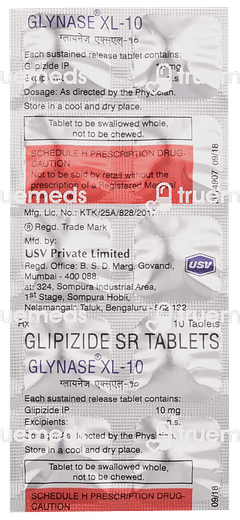Glipizide
Uses of Glipizide
The primary use of Glipizide is to manage blood sugar levels in patients with type 2 diabetes mellitus. It falls under the class of medicines known as sulfonylureas.
Apart from this primary use, there are no significant secondary uses of Glipizide as it is specifically designed to help manage type 2 diabetes.
Side effects of Glipizide
Low blood sugar
Dizziness
Diarrhoea
Nausea
Headache
How Glipizide works
Glipizide is a part of the sulfonylurea group of medicines.
It operates by interacting with ATP-sensitive potassium channels found on pancreatic beta cells in your body. It blocks these channels, causing the beta cells to change their charge, leading to the opening of calcium channels. The sudden influx of calcium into these cells triggers the release of insulin from your pancreas. This insulin then helps move sugar from the bloodstream into your body's cells where it is used for energy. Glipizide also seems to increase your body's sensitivity to insulin. As a result, glucose in your blood is more efficiently absorbed and utilised, helping manage blood sugar levels in people with type 2 diabetes.
Certified content
Written By

Doctor of Medicine
Reviewed By

BMS, FMC, MD Resident
Expert Advice
Dosage Forms Available
Glipizide can be taken orally (regular and extended-release tablets).
Age and Dose Restrictions
Glipizide is intended for use in adults.
Contraindications
Glipizide is contraindicated in patients with known hypersensitivity to Glipizide or other sulfonylureas. It is also not indicated for patients with type 1 diabetes, diabetic ketoacidosis or severe kidney or liver disease.
Other Medications to Avoid
Glipizide may interact with antidiabetic medicines (such as insulin, and metformin), beta-blockers (such as propranolol, and metoprolol), corticosteroids (like prednisone), diuretics (like hydrochlorothiazide), anticoagulants (like warfarin) and antifungals (such as fluconazole, and miconazole).
Overdose and Missed Dose
An overdose of Glipizide may cause symptoms like nausea, vomiting, stomach pain, drowsiness, seizures or unconsciousness. If you suspect an overdose, seek immediate medical attention.
If you miss a dose of Glipizide, take it as soon as you remember. If it is almost time for your next dose, skip the missed dose. Do not double up the dose to make up for a missed one.
Management of Side Effects
Most side effects are temporary and generally harmless and resolve when discontinuing this medicine. However, if you experience any severe side effects or worsening of any of the symptoms, please consult your doctor.
Drinking plenty of water can help manage some common side effects like dizziness and headache.
Taking the medicine with meals helps reduce the risk of stomach upset.
Use in Driving and Operating Machinery
Glipizide may cause dizziness and blurred vision. Therefore, caution is advised while driving or operating machinery until you know how this medicine affects you.
Use in Pregnancy and Lactation
Glipizide should be used during pregnancy only if the potential benefit justifies the potential risk to the fetus. Because it is not known whether Glipizide is excreted in human milk, caution should be exercised when Glipizide is administered to a nursing woman.
Caution in Other Conditions
Patients with G6PD deficiency should use Glipizide with caution as it may cause hemolytic anaemia.
Patients with kidney or liver impairment may require dose adjustments due to the slower clearance of Glipizide from the body.
Special Dietary and Lifestyle Recommendations
Avoid high-sugar foods and beverages to prevent blood sugar spikes.
Regular monitoring of blood glucose levels is recommended for optimal diabetes management.
Frequently asked questions
Is Glipizide a steroid-based medicine?
No, Glipizide is not a steroid-based medicine. It belongs to a class of medications known as sulfonylureas, which are used to manage type 2 diabetes.
Can Glipizide cause sleep disturbances?
Some people taking Glipizide may experience dizziness as a side effect, which could potentially lead to sleep disturbances. However, this does not occur in everyone. If you are having trouble sleeping while taking this medicine, you should consult with your doctor.
Does Glipizide affect fertility levels?
Currently, there is no scientific evidence to suggest that Glipizide directly affects fertility levels in men or women. However, poorly managed diabetes can affect reproductive health. Therefore, it is recommended to manage your blood sugar levels effectively for overall health, including reproductive health.
Is it safe to take Glipizide on a daily basis?
Yes, Glipizide is usually prescribed to be taken every day as part of a comprehensive plan to manage type 2 diabetes. However, you should always follow your doctor's instructions regarding how often and when to take this medicine.
How long does it take for Glipizide to start working?
Glipizide typically begins to lower blood sugar levels within two to three hours after taking it orally. This is because it works by stimulating the pancreas to produce more insulin and helps the body use insulin more efficiently.
What is the best time to take Glipizide?
Glipizide should be taken about 30 minutes before a meal, typically breakfast. This allows the medication to be in your system and ready to work when you begin eating.
Can Glipizide cause weight gain?
Yes, weight gain is a potential side effect of Glipizide and other sulfonylureas.
Glipizide in other salts







Subscribe
Claim your complimentary health and fitness tips subscription and stay updated on our newest promotions.
Download Truemeds
Manage your health with ease Download Truemeds today!Get easy access to medicine refills, health information, and more. With our app, you'll never have to wait in line again. Download now and start taking control of your health.

Contact Us
Our customer representative team is available 7 days a week from 9 am - 9 pm.
v3.4.14
Our Payment Partners








